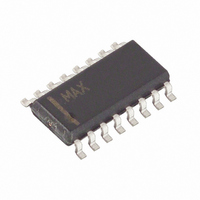DS2715Z+ Maxim Integrated Products, DS2715Z+ Datasheet - Page 13

DS2715Z+
Manufacturer Part Number
DS2715Z+
Description
IC NIMH CHARGER 16-SOIC
Manufacturer
Maxim Integrated Products
Datasheet
1.DS2715Z.pdf
(17 pages)
Specifications of DS2715Z+
Function
Charge Management
Battery Type
Nickel Metal Hydride (NiMH)
Voltage - Supply
4.5 V ~ 16 V
Operating Temperature
-20°C ~ 85°C
Mounting Type
Surface Mount
Package / Case
16-SOIC (0.154", 3.90mm Width)
Operating Supply Voltage
16.5 V
Supply Current
1.3 mA
Maximum Operating Temperature
+ 85 C
Minimum Operating Temperature
- 20 C
Charge Safety Timers
Yes
Mounting Style
SMD/SMT
Temperature Monitoring
Yes
Uvlo Start Threshold
3.9 V
Uvlo Stop Threshold
35 mV
Lead Free Status / RoHS Status
Lead free / RoHS Compliant
DS2715: NiMH Battery Pack Charge Controller
Application Circuits
Switchmode
Figure 5 shows a typical DS2715 switchmode application circuit for charging a 3-cell battery stack. Connecting the
MODE pin to CBIAS enables the comparator mode of current regulation. The DS2715 regulates the current
through the current sense resistor R7 by switching Q1 on and off as the sense resistor voltage ramps up and down
toward the preset sense voltage thresholds. The .1ohm sense resistor along with the DC ground-referenced sense
threshold level of -(V
+ V
/2) sets the average charge current in the example to 1.07A. The sense resistor
FC
HYS-FC
should have a proper power rating for the chosen charge current.
Figure 5. TYPICAL Switchmode APPLICATION CIRCUIT FOR A 3-CELL
STACK
A bootstrap subcircuit with C5, R3 and Q3 is used to improve the turnoff time of Q1 to minimize switching losses.
When V
is pulled low to turn on Q1, C5 is charged through the R6/R3 path. When V
is left open-circuit to turn
CH
CH
off Q1, the voltage of the V
node jumps up close to the gate voltage of Q1. This causes the gate of Q3 to be
CH
pushed up due to the voltage across C5. Q3 is then turned on, which helps to speed turn-off of Q1 by discharging
its internal capacitances. The values of the components in this section of the circuit are tuned to work with the
chosen transistors. The values of R6 and R9 should be chosen so that no more than 20mA is sunk by V
. D4 is
CH
used to clamp the inductive spike that could occur if the batteries are removed during charging. This function can
also be served by an energy absorbing capacitor placed in parallel with the battery stack.
Q2 is used to float the Rt pin when the supply source is disconnected. This puts the DS2715 into SUSPEND mode
and resets the state machine. D1 prevents current from flowing into the charge source. D2 and R2 create the
maintenance charge current path. D1, D2 and R2 should be sized appropriately for the wattage they must dissipate
based on the application parameters. R1 and C3 create a low pass filter to minimize noise transfer as the DS2715
local ground moves in relation to the system or charge source ground.
13 of 17








